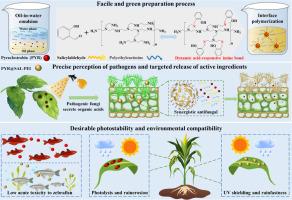Nanocapsules bearing imide polymer as wall material for pH-responsive and synergistic fungicidal activity
IF 13.2
1区 工程技术
Q1 ENGINEERING, CHEMICAL
引用次数: 0
Abstract
Stimuli-responsive controlled release systems (SPRS) have the potential to improve both the efficacy and persistence of pesticides, presenting significant opportunities for application in agricultural production. Herein, stimuli-responsive nanocapsules (PYR@SAL-PEI) were developed using Schiff base complex of salicylaldehyde (SAL) and polyethyleneimine (PEI) as wall materials to encapsulate the photosensitive pesticide pyraclostrobin (PYR) to improve its utilization efficiency and reduce environmental risks. The results showed that the obtained PYR@SAL-PEI nanocapsules with pH-responsive release characteristics exhibited a uniform particle size (approximately 300 nm), high encapsulation efficiency (94.30 %), and loading capacity (25.80 %) under optimal preparation conditions. The nanocapsules displayed excellent physicochemical properties including enhanced PYR photostability (approximately improved 11-times compared to PYR technical), rainfastness and maximum retention on crop leaves. In vitro and in vivo antifungal activity tests showed that the nanocapsules had superior antifungal activity against Botrytis cinerea and Sclerotinia sclerotiorum compared to commercial PYR suspension concentrate, and showed a prolonged persistence. Furthermore, the nanocapsules significantly reduced the acute toxicity of the PYR to adult zebrafish, demonstrating a favorable environmental safety. Therefore, the novel Schiff base complex based nanocapsules with synergistic antifungal activity would provide a promising solution for the efficient delivery of pesticides, offering wide application prospects.

以亚胺聚合物为壁材的具有ph响应和协同杀菌活性的纳米胶囊
刺激反应型控释系统(SPRS)具有提高农药药效和持久性的潜力,在农业生产中具有重要的应用前景。本文以水杨醛(SAL)和聚乙烯亚胺(PEI)的希夫碱配合物为壁材,制备了刺激响应型纳米胶囊(PYR@SAL-PEI),用于包封光敏农药吡咯菌酯(PYR),以提高其利用效率,降低环境风险。结果表明,在最佳制备条件下,获得的PYR@SAL-PEI纳米胶囊粒径均匀(约300 nm),包封效率高(94.30 %),载药量高(25.80 %),具有ph响应释放特性。纳米胶囊表现出优异的物理化学性能,包括增强的PYR光稳定性(与PYR技术相比,大约提高了11倍)、耐雨性和在作物叶片上的最大保留率。体外和体内抗真菌活性试验表明,该纳米胶囊对葡萄灰霉病菌和菌核菌的抗真菌活性优于市售PYR悬浮液浓缩液,且持续时间较长。此外,纳米胶囊显著降低了PYR对成年斑马鱼的急性毒性,显示出良好的环境安全性。因此,具有协同抗真菌活性的新型希夫碱配合物纳米胶囊将为农药的高效递送提供一个有希望的解决方案,具有广阔的应用前景。
本文章由计算机程序翻译,如有差异,请以英文原文为准。
求助全文
约1分钟内获得全文
求助全文
来源期刊

Chemical Engineering Journal
工程技术-工程:化工
CiteScore
21.70
自引率
9.30%
发文量
6781
审稿时长
2.4 months
期刊介绍:
The Chemical Engineering Journal is an international research journal that invites contributions of original and novel fundamental research. It aims to provide an international platform for presenting original fundamental research, interpretative reviews, and discussions on new developments in chemical engineering. The journal welcomes papers that describe novel theory and its practical application, as well as those that demonstrate the transfer of techniques from other disciplines. It also welcomes reports on carefully conducted experimental work that is soundly interpreted. The main focus of the journal is on original and rigorous research results that have broad significance. The Catalysis section within the Chemical Engineering Journal focuses specifically on Experimental and Theoretical studies in the fields of heterogeneous catalysis, molecular catalysis, and biocatalysis. These studies have industrial impact on various sectors such as chemicals, energy, materials, foods, healthcare, and environmental protection.
 求助内容:
求助内容: 应助结果提醒方式:
应助结果提醒方式:


